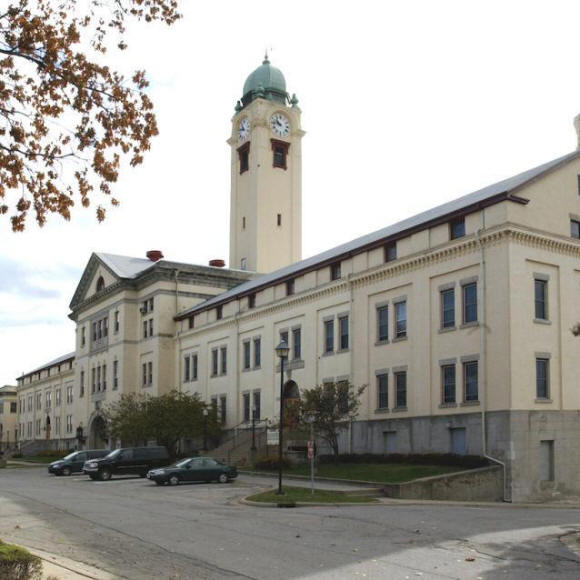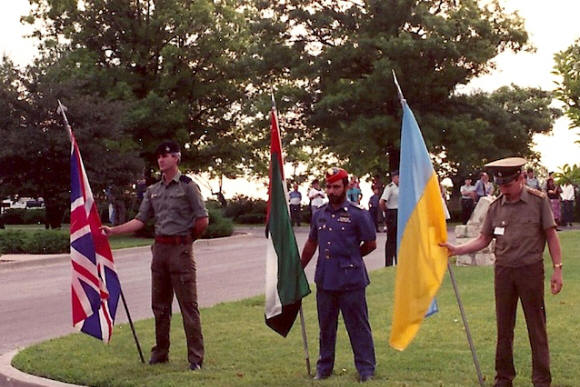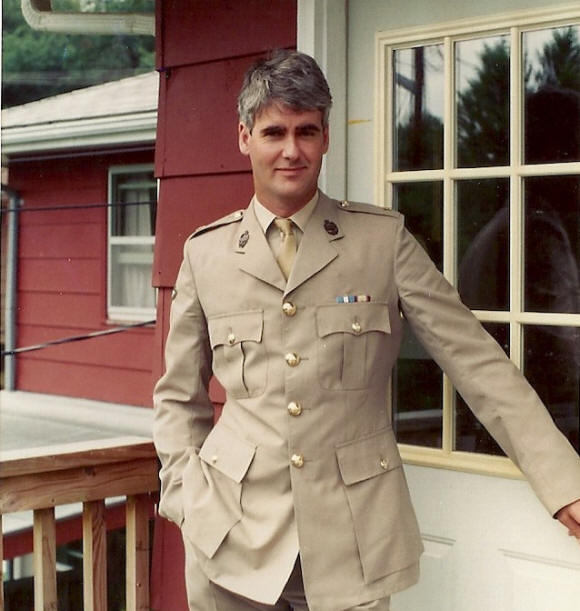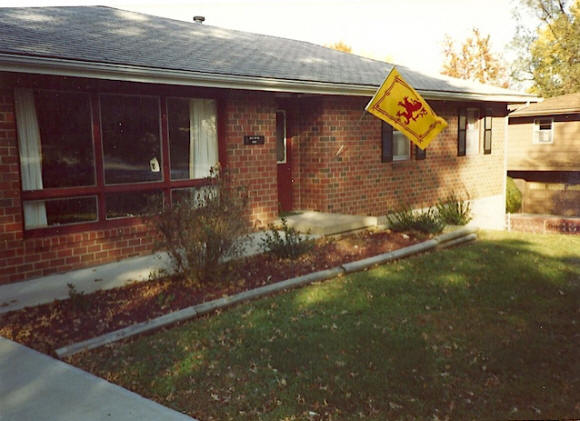|

FORT LEAVENWORTH
FORT
LEAVENWORTH, was founded in 1827 and is situated on a
strategic bend in the Missouri River – on whose banks
you can still discern the ruts made by the wagons of the
earliest settlers if you know where to look – and it’s
where as previously stated the US Army Command & General
Staff College (henceforth USACGSC) is located. The
contiguous county town of Leavenworth, to which the Fort
has given its name, is a typical small mid-western town
of roughly 36,000 souls.
Leavenworth’s main claim to fame is the number of
prisons it boasts, including the federal US
Penitentiary, Leavenworth, and the US Disciplinary
Barracks, the US Army’s only maximum security prison.
Although these institutions give the town a somewhat
severe façade, it is a pleasant place to live and work,
and not too far from Kansas City for those who seek a
bigger environment and brighter lights.
Rather naively I had assumed that being a fort it would
have a guarded perimeter, or perhaps even a traditional,
historic palisade curtilage like those featured in every
western film you have ever seen, but not so. It is more
of a cantonment than a fort, at least it was in those
pre-9/11 days, and open on all sides. It is also home to
several other US Army schools and colleges and has the
reputation of being “the intellectual center (sic) of
the US Army”.

Holding the Union Flag at the course opening ceremony.
Where do
I begin to describe the US Army staff course? Well, for
starters, there were 1,280 students on the course I
attended, about ten times the number of the equivalent
British course then at Camberley. The vast majority
were, unsurprisingly, Americans drawn from all four of
their services – Navy, Army, Airforce and Marines. We
“International Students”, as we were called, numbered
about 70 if I remember correctly and I was the sole UK
representative. The course also included the first
Russian and first Ukrainian army officers, part of the
general rapprochement following the dissolution of the
Warsaw Pact.
The course itself followed the usual curriculum on
doctrine, tactics, and leadership and was taught mainly
in small syndicate groups of about ten, presided over by
a US Army Lieutenant Colonel (British abbreviation Lt
Col, American LTC; don’t get me started on Americanisms
… ). I have to say I was very impressed by my new
American colleagues on the whole. They were professional
if a tad serious but were good at what they did. There
was an enormous amount of reading doled out as part of
the course, and I warmed to them even more when one of
them whispered in class to me “it’s only a lot of
reading if you actually do it”. My sort of people!
There were, of course, many aspects that I found quite
amusing, in a laugh-with-them rather than a
laugh-at-them kind of way. One that struck me straight
away was that it was impossible for me at first to
distinguish very senior officers from my lowlier
compatriots. They all wore the same uniform, and
sometimes the only indicator of rank would be a discreet
five stars (that’s pretty senior by the way) hidden on a
rank slide on a uniform indistinguishable from everybody
else’s. Addressing the US Army’s Chief of Staff as
“mate” as you politely ask him to get out of the way is
not seen as best practice, not in anyone’s army, but you
couldn’t tell.

Moi, in my tropical service dress on the back porch.
They also
had a pathological fascination with getting their hair
cut. The onsite barbers seemed to be at it day and
night, with queues of US Army officers outside its door
waiting for their already extraordinarily short hair to
be coiffed even shorter. It was a bit like a skinheads’
convention at times, without the big boots and tattoos.
Meanwhile we Europeans were swanning around the campus
in our strange and outlandish uniforms tucking our
flowing locks into our berets. To be honest, much of the
time I made my uniform up; whatever was comfortable or
clean would do in any combination. Who knew otherwise?
The hours that many of them kept were also a source of
constant amazement. It was not unusual for the US
students on the course to be in work at 5 am, which was
close to when some of the International Officers were
just going to bed. In the evening they would turn in at
9.30 pm, which was before many of us had had our evening
meal, ready to get up fresh and eager for the next
working day. Just couldn’t understand it, but each to
their own I guess.
But I must say again just how welcoming, pleasant, and
kind our hosts were. And they too must have been amused
by us much of the time. When at work my American chums
seemed to be unfazed by anything they were asked to do
or any role they were asked to play. Tell a British
student at one of the UK staff colleges at a map
exercise that they’re to fill the role of Corps
Commander and they’ll have kittens; tell an American the
same thing and they’ll deal with it exactly the same as
they would if asked to command a platoon. They were, and
probably still are, much more comfortable at scale than
we are.
We had a couple of trips within the USA as part of the
course and they were good fun; not quite as hedonistic
as similar trips undertaken by the British staff college
back in the day but fun nonetheless. The detail is lost
to me now, but I do remember one aspect of a trip to
Washington DC, where we visited the Pentagon and similar
institutions. One of our number, a Kiwi SAS officer and
serious rugby player, took great delight in saying to
everyone we met in the streets wearing a back-to-front
baseball cap – which was virtually every male under
twenty-five – “excuse me, do you realise you’re wearing
your hat the wrong way round?”, which provided endless,
childish amusement. Looking at him it was clear that
no-one was going to object.

The house I rented in Leavenworth complete with a Lion
Rampan
There was
much greater emphasis on the reading of military history
than there had been at Camberley as far as I can
remember. Our first piece of required reading was The
Killer Angels, a historical novel by Michael Shaara that
was awarded the Pulitzer Prize for Fiction in 1975. The
book depicts the three days of the Battle of Gettysburg
during the American Civil War, much of it told through
the real life character Colonel Joshua Lawrence
Chamberlain of Maine, whose 20th Maine Volunteer
Infantry Regiment held the left of the Union line during
the battle and whose defence of a feature known as
Little Round Top was critical to the defeat of the
Confederate Army.
We visited the battlefield, and stood on Little Round
Top, which was a sobering but fascinating experience. I
was also able during my time in Leavenworth to research
and present to my classmates on the Battle of Caporetto
(aka Twelfth Battle of the Isonzo) in 1917, a heavy
Italian defeat at the hands of the Germans and
Austrians, of particular interest to me as my
grandfather had been there. Few people realise that
there were British troops fighting in Italy in the First
World War, but there were. My grandfather was part of an
all volunteer medical unit which he had joined with all
his pals, as they did in those days. Typically, he never
spoke very much about it, except to say that he had been
“the first man in the retreat” and his Italian comrades
had all thrown their rifles in the canal and run away.
Perhaps they had learned that a German officer called
Rommel was one of those attacking them!
The senior American officers who came to speak to us
were very impressive. Many of them had served in the
Vietnam War and were grizzled old veterans, and some had
also been involved in Desert Storm in 1991. They tended
to bounce on to the stage in the vast central auditorium
deep in the college and shout out the name of the
syndicate they had been part of when they had attended
in the past. This usually resulted in the current
iteration of that syndicate jumping to their feet and
shouting “hooaah!” in the way that American soldiers
tend to do. It was great theatre, and the generals were
great speakers, much better than their British
equivalents in my opinion.
The course was overall a very busy and comprehensive one
and thoroughly enjoyable for me and my fellow
International Officers. It wasn’t all work, of course,
and away from the course there were a myriad of other
social, sporting, and cultural events which went on.
Some of them were great fun to take part in and showed
colourful aspects of mid-Western life which were, in
some cases, not too far from the Hollywood images so
familiar to all of us. I’ll write more about this in the
next episode.
To come in Part 33; living and working (and playing) in
Kansas (continued).
Photos by
the author. |

